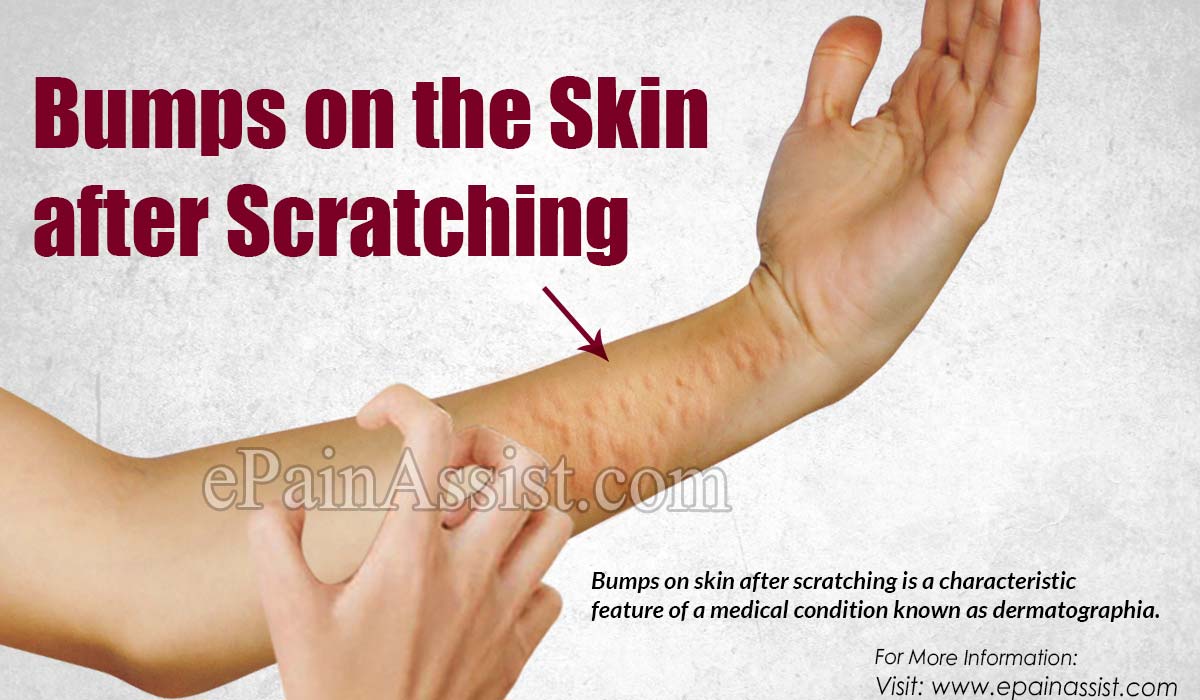Bumps on the Skin after Scratching
Bumps on skin after scratching is a characteristic feature of a medical condition known as dermatographia. Dermatographia is popularly known as ‘skin writing’; and also known by the names dermatographic uticaria and dermographism. It is characterised by minor skin scratches resulting in temporary skin reaction. This condition mainly affects young adults and older children; it is seen in about 5 percent of the population. The bumps that appear after scratching are white or red in colour and heal very quickly. There is no exact cure for this condition and most of the symptoms does not require any active treatment and resolves on its own. However, in extreme cases, antihistamines provide relief.

Symptoms Associated with Bumps on the Skin after Scratching
The symptoms associated with dermatographia do not appear on its own. They appear on skin after scratching and usually appear without any prior warning. The most common symptoms are described below:
- Bumps over skin or raised bumps over skin that appears as writing
- Redness
- Hives and swelling
- Itchiness
- Inflammation
- Deep wounds in some cases.
Bumps on skin after scratching and its associated symptoms last for about half an hour and then resolve on its own. In few cases, the symptoms last for a day or more. The Bumps on skin after scratching and its symptoms are repetitive in nature and last from months to years. It has been noted that the condition usually worsens with changes in temperature. Extreme increase in temperature or decrease in temperature aggravates the symptoms. Hot, cold and dry weather, and also hot showers, sauna etc. worsens the condition.
Risk Factors Associated with Bumps on the Skin after Scratching
The risk of developing bumps on skin after scratching increase in the presence of following condition:
- Dry skin
- Known history of dermatitis
- Young adult or old children
- Itchiness over skin leading to scratching
- Presence of underlying conditions such as thyroid issues or nerve disorder causing itchy skin.
Causes of Bumps on the Skin after Scratching
The exact cause of this condition is yet unknown. A lot of researches are being carried out to understand what causes Bumps on skin after scratching. It has been noted that the most common triggering agents are:
- Excessive stress
- Known history of allergies
- Skin irritation from rubbing the skin with clothing or bedding
- Skin infections
- Reactions to certain medications such as penicillin
- Excessing skin rubbing from activities such as exercising etc.
Diagnosing Bumps on the Skin after Scratching
Diagnosis of bumps on the skin after scratching is done by a skin specialist or a dermatologist. A detailed case history is obtained along with physical examination of the skin. A skin test is usually performed to study the reaction. This is done using a tongue depressor, which is dragged against the skin to note any adverse reaction. Other areas are examined to look for other signs and symptoms. Diagnosis usually does not involve blood work or x-rays; unless there is a need to rule out possibilities of other conditions.
Treatment and Management of Bumps on the Skin after Scratching
As mentioned earlier, most of the cases of bumps on the skin after scratching do not require any treatment. Treatment is required if the condition becomes troublesome or chronic. Most of the symptoms are manageable with over-the-counter medications such as anti-histamine. However, it is advised to consult a physician before starting any medication. The most common treatment modalities are discussed below:
Conventional Treatments for Bumps on the Skin After Scrathing:
Over-the-counter medications such as Benadryl, Zyrtec, Claritin, Allegra helps in management of symptoms caused by dermatographia. Specialised treatment such as phototherapy is often helpful in controlling the condition. Phototherapy is a type of radiation therapy used for management of skin issues.
Alternative Treatments for Bumps on the Skin after Scratching:
Natural products such as aloe vera, tea tree oil, rice bran broth, oatmeal etc. have a soothing effect on the skin. These help in reducing inflammation and itchiness. Some patients have found acupuncture helpful. It has also been seen that borage oil, primrose oil, fish oil and multi-vitamins also help in management of dermatographia. However, there isn’t enough evidence to support it at the moment.
Lifestyle Changes:
Activities which help in controlling stress and help in boosting mood uplifting hormones also helps in reducing these symptoms. Yoga, breathing exercises, and meditation are helpful in this regard.
Prognosis of Bumps on the Skin after Scratching
Bumps on skin after scratching do not last for long, but the condition itself may linger for years. Most of the symptoms respond well to over-the-counter medications, but few adverse cases may need dermatological consultation.
Prevention of Bumps on the Skin after Scratching
The reactions of bumps on the skin after scratching can be limited if few preventive measures are followed. These lifestyle changes and preventive measures are described below:
- Avoid contact with skin irritants such as itchy bedding or clothing such as wool or synthetic material.
- Avoid using soaps with dyes, fragrances, and harsh chemicals.
- Avoid baths and showers and extreme temperature.
- It is recommended to use a humidifier during cool and dry months.
- Use a skin friendly moisturizer soon after a shower to avoid dryness.
- Limit scratching.
- Stress management with adequate sleep, exercises and meditation.
- Healthline. (2021). Dermatographia: What You Need to Know About Skin Writing. https://www.healthline.com/health/dermatographia
Also Read:
- Types of Eyelid Bumps & Treatment to Get Rid of it
- Causes of Heat Bumps & Home Remedies to Get Rid of it
- Red Bumps on Baby: Causes, Symptoms, Treatment, Prognosis, Prevention
- Are Bumps on Lower Lip Contagious?|Causes, Treatment, Home Remedies for Bumps on Lower Lip
- 15 Useful Home Remedies To Get Rid Of Red Bumps On Legs
